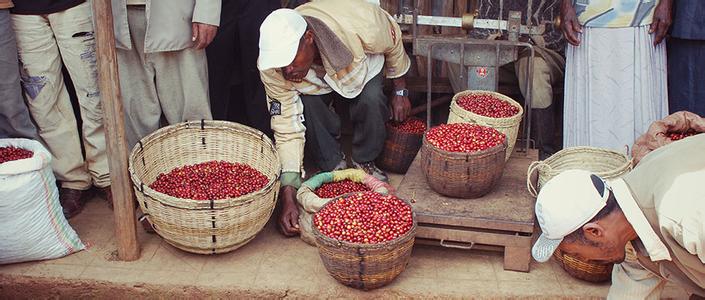Addis Ababa: in the place where coffee originated
When the slow secretion of oil makes dark brown coffee beans shine, it is time to grind coffee. There is no bean grinder, and wooden pestles and mortar are completely used to mash the coffee beans in the coffee ceremony. In this way, it is destined that the coffee powder will not be too delicate and looks similar to the "medium grinding" degree of the bean grinder. Such a fine powder is just right for the next step of brewing coffee. On the charcoal fire, the water in the pottery pot boiled and smoked, and Jenna poured the coffee powder into the pot. This pottery pot is very simple and has no structural mystery. After waiting for a while, she poured the coffee into a large glass cup and poured it back into the clay pot, three or four times. I am actually a little confused about this process, because the uncontrollable size of charcoal fire and the process of repeated dumping will wear out the aroma of coffee. Jenna stressed that this link should have a good control of time. The allocation of specific time depends entirely on experience. Since childhood, she has seen her mother to preside over the coffee ceremony at home. "every day after school, I will smell coffee and frankincense when I come to my house. It makes me feel warm, because it means that my mother is at home, waiting for me. "
When the dregs precipitate a little, the coffee can be divided. First of all, it is necessary to bring coffee to the oldest male elder in the family, not only as a sign of respect, but also because the coffee first baked has the strongest flavor and is not suitable for women and children. Coffee should be served in three rounds, each with no new coffee powder, just water. If the first round is likened to espresso (Espresso), the last round is like American coffee (Americano) diluted with water, and children who are not very young at home can participate. The snacks that go with coffee are popcorn and fried wheat.
"if Ethiopians invite you to a coffee ceremony, you must not refuse, otherwise it will be a serious social mistake." A local Chinese friend told me. Once he went to the countryside for an inspection. Before he left, an old man in the village offered to invite him to his home to participate in the coffee ceremony. Thinking that he had an itinerary to hurry after, he told the translator that he wanted to decline politely. Unexpectedly, the translator told him directly that such an invitation must be accepted. Coffee ceremony is a kind of high-standard etiquette for hospitality, and it is also an activity when relatives and friends get together. It is said that it also has the function of resolving conflicts. In short, the core of the coffee ceremony is to gather human feelings, not just for that drink.
In Ethiopian tradition, coffee ceremonies take place at home three times a day, after breakfast, lunch and dinner. The pace of modern life requires that the frequency has been reduced to once a day. There is a local proverb "Coffee is bread". It still takes too much time to brew coffee at home, so people might as well go to the street to buy it. This is particularly evident in some small towns outside the capital. When I visited the ancient cities of the three historic centers of northern Ethiopia, I often saw women selling coffee with pottery pots on charcoal stoves and rows of small ceramic bowls. People often choose a coffee stand nearby to have a cup or two and have a few pleasantries with the hostess. Such a scene is somewhat similar to the scene of selling large bowls of tea on the streets of Beijing in the early 1990s, characterized by cordial and casual. For example, the big bowl of tea uses "high end". The coffee beans selected by this coffee stand are also mixed with some "defective beans", but the taste is always familiar.

Important Notice :
前街咖啡 FrontStreet Coffee has moved to new addredd:
FrontStreet Coffee Address: 315,Donghua East Road,GuangZhou
Tel:020 38364473
- Prev

Ethiopia coffee beans grinding scale varieties of production area treatment method Manor introduction
In Ethiopia, coffee classification and quality control systems are divided into producer, regional and national levels. All coffees are inspected by local inspection agencies before they leave the country of origin, and then re-inspected at coffee inspection and grading centres in Addis and Diredova to determine their quality grade. Coffee is graded prior to auction and sale, and all participants in production, acquisition,
- Next

Introduction to the flavor and taste of the cultural description of the origin of Ethiopian coffee bean story
The origin of Ethiopian coffee bean story, cultural description, flavor and taste introduction there is a small town in southern Ethiopia called Kafa, which is the earliest birthplace of coffee. But now Ethiopia is most famous for coffee beans with the trademarks of Hal, Sidamo, and Yejasuffe. In fact, most of Starbucks' raw materials come from these three brands. Ethiopia is now lost.
Related
- Detailed explanation of Jadeite planting Land in Panamanian Jadeite Manor introduction to the grading system of Jadeite competitive bidding, Red bid, Green bid and Rose Summer
- Story of Coffee planting in Brenka region of Costa Rica Stonehenge Manor anaerobic heavy honey treatment of flavor mouth
- What's on the barrel of Blue Mountain Coffee beans?
- Can American coffee also pull flowers? How to use hot American style to pull out a good-looking pattern?
- Can you make a cold extract with coffee beans? What is the right proportion for cold-extracted coffee formula?
- Indonesian PWN Gold Mandrine Coffee Origin Features Flavor How to Chong? Mandolin coffee is American.
- A brief introduction to the flavor characteristics of Brazilian yellow bourbon coffee beans
- What is the effect of different water quality on the flavor of cold-extracted coffee? What kind of water is best for brewing coffee?
- Why do you think of Rose Summer whenever you mention Panamanian coffee?
- Introduction to the characteristics of authentic blue mountain coffee bean producing areas? What is the CIB Coffee Authority in Jamaica?

